 THE KELPIE
STORY
THE KELPIE
STORY THE KELPIE
STORY
THE KELPIE
STORY
|
|
If you breed any two purebred Kelpies together then you get a purebred Kelpie. That is a fact! Obviously the breeding has to be honest and the parents have to be purebred Working Kelpies. Just because you or someone else doesn't like the looks of the dog, the colour or the markings, doesn't change that fact. Some breeders can be very pedantic about what they feel is the 'correct' colours or markings. This knowledge is usually only based on the dogs they are personally breeding or the ones they prefer. It is more common in city people than rural Kelpie people.
The main purpose of the Kelpie is to work the millions of sheep, cattle and goats in Australia. Without the help of the wonderful Kelpie, Australia may never have become one of the greatest wool producing countries in the world. Colour and beauty are very secondary considerations and should always be treated as such. While running a breeding program for colour characteristics can be challenging and a lot of fun, the fact remains that it is really one of the very least important aspects in working dogs.
Over the years we have been breeding we have had just about every colour and every combination possible. We don't breed for colour. It just isn't that important. Many of the photos on these pages are of our old Noonbarra Kelpies. We are now glad we bothered to keep a photographic record of them.
Colour is a funny thing. Often people with a black & tan Kelpie will call him a black dog. A red & tan might be referred to as a brown dog. Creams are often called 'Blondes' or 'Yellows'. While it doesn't mean much it can be confusing when studying historical references. Some photos of the famous blue Kelpie, Coil show that he was actually a blue and tan. King & McLeod's Biddy has long been thought to be a solid red colour but one photo of her shows she was a red & tan Kelpie. Were some of the original black Kelpies really black & tan Kelpies ? I guess we'll never know unless more historical photos are uncovered.
GUIDELINES FOR THE WORKING KELPIE (The Standard)
The first guidelines for Kelpie appearance were written up in 1902 by dog show enthusiast, journalist and author, Robert Kaleski. He wrote this 'Breed Standard' up in an article he wrote for the Agricultural Gazette of New South Wales. This was for the most common black and tan coloured Kelpie only. However, at the time other colours were also well established. This set of guidelines was updated a few years later and included a few more colours. The Kennel Club of NSW later accepted this standard.
Mr. Kaleski said that before he wrote out a standard, Kelpies and Cattledogs that were exhibited in the show ring were judged only on the whim of the individual judge. Mr. Kaleski himself felt he had been the subject of some bad decisions by show judges. He started showing these working dogs in 1897.
Most breeders of the Australian Working Kelpie don't care what the dog looks like as long as he is intelligent, has plenty of stock ability and is functional. Other breeders worry a lot about the physical appearance. The Standard still being used today by some breeders of Working Kelpies is actually set up by the Show Society for the Show (Bench) Kelpies. This standard was based on the original set of guidelines put together by Robert Kaleski. Every few years it is updated and adjusted to reflect any changes in the Show Kelpies being exhibited. The current Showing Standard excludes a number of common Kelpie colours as not being suitable to be shown. It all seems a bit silly to us.
It is a bit narrow-minded that the Show Society has set up a 'Standard' for the Kelpie that does not accept Fawn & Tan, Blue & Tan, Cream, or White markings. These colours have always been a part of purebred Kelpies. The main dogs preferred for the show ring are dark solid reds (often referred to as 'Chocolate') and a few full solid blacks.
Many people think that different colours have different ability. This is not the case. It is the working genes that make up the working ability not the colour. There have been many great Australian Working Kelpies of all colours.
WHITE MARKINGS IN KELPIES
For some reason a few people think that Kelpies should not have any white markings. Some people can get very heated about the subject but I've never understood why. It was even included in the original Kelpie standard. In the show world it was soon deemed 'not desirable' but it didn't take long before it came to be seen as a fault, which of course it is not.
While in some people's eyes, the lack of white makes the Kelpie look more uniform and is desired by many people who want pretty looking dogs with clean markings, the truth is that very few Kelpies are ever born without at least some white somewhere on their body. Some of the show people even go to the extent of pulling out white hairs or dying them. I've even seen them burn off the white hairs with cigarettes.
Some of the greatest Kelpies of all time had a lot of white on them. For a start the first Kelpie ever, Gleeson's Kelpie, a dog born around the late 1860's was described as a black and tan colour with some white on the chest and under her jaw. She had tan legs and erect ears that slightly turned over at the tips. Her ears were said to go up and down as she worked.

In the first set of guidelines ever written for the Kelpie (By Robert Kaleski). It said that with black & tan Kelpies "Head black, with tan spot over each eye, body black, sometimes with white blaze on chest..." The current standard used by people who show dogs does not include white markings, cream or tan Kelpies, no Blue & tans, no fawn & tans, no mention of masked dogs or banded colouring etc.
Mr. Tony Parsons of the well known Karrawarra Kelpie Stud and author of a number of books on the Kelpie had this to say." In contrast to the original standard (1902) the ANKC does not mention white at all. It would seem that no white is permitted. This is a mistake, as many Kelpies do have white on the chest and I think that if we are to have a standard, it should accept this fact. Likewise, it should include all colours." - The Australian Kelpie Published - 1992.
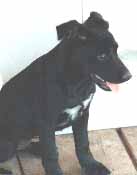
Also one of the earliest Kelpies of the 1800's, called Lass and owned by Steve Apps of Merrigreen Station was described as being strangely marked. She was a black and brown dog with a lot of white on her. Her breeding was Tully's Moss X Gleeson's Kelpie. The famous Red Hope was another with a fair amount of white on the chest. Then there was the big sheepdog trial winner, Newton Nap. He had a wide stretch of white going from the top of the neck right down under his chest. Newton Jennie won the award for the Maiden as well as the Open Sheepdog Trial at the Sydney Sheepdog Trials in 1948. This was by far the biggest and most prodigious trial in Australia. Jennie also won the award for the best type Kelpie. She had a lot of white on her chest too.
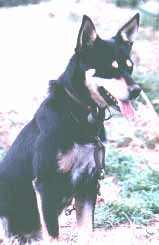
Haynes Ring is another that had a lot of white on the chest and neck. He was very highly regarded by some of the best Kelpie men of the period including Frank Scanlon and John Quinn. Stan Collins said that Ring was "the only real sheepdog I ever saw". He was the sire of the famous Scanlons Dell.
Port Patrick Taj was an outstanding trial dog owned by Bert Bromham of the Glenville Stud. We never saw this dog in person but have been told he had a lot of white on him, including some white up the leg. This highly regarded Kelpie is found in hundreds of pedigrees today. There was also Glenville Dot and Karrawarra Sergeant in the Glenville Stud and they both had white on them.
In his book, The Australian Kelpie, Tony Parsons wrote the following paragraph. (The Sydney Sheepdog Trials were the best and most prestigious in Australia at that time).
" I remember well one show breeder criticising Newton Jennie because of her white chest. Jim Moore had Jennie and (Newton) Fawn sitting on the showground hill and some of the bench fanciers were walking past him on their way to the big bench show they used to hold at sheep show time."
"This was in 1948 and Jennie won the Sydney Maiden and Open Trials - something that not one of those bench dogs would have had the remotest chance of doing, even if given the opportunity. I thought then that the two camps were world's apart. I have seen nothing since that time that would cause me to alter that opinion." - Tony Parsons 1992
There have been thousands of other good Kelpies with at least some white markings. Even King & McLeod's famous Kelpie Biddy had some white markings and she was widely promoted as a perfect example of a Kelpie in the early years of the 1900's. She was also winner of the 1902 Sydney Sheepdog Trials.
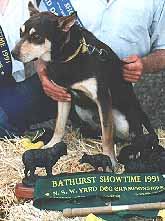
Many years ago a neighbour of ours had a number of well-bred Kelpies from one of Australia's biggest breeding establishments. He had paid big money for the dogs and stated that a Kelpie should not have any white on them and his dogs didn't have any white markings. I then called over his dogs and looked under their chests. Both dogs had a stripe of white about six inches long. The owner of course was quite surprised. He had just never looked under the chest.
Dr. Chris Walker of Sydney Australia wrote an 8 page article in 1986, titled ' Observations on the Inheritance of Coat colour in Australian Kelpies'. It was published in the Canine Journal, the official publication of the NSW dog showing fraternity (ANKC). He wrote: " I believe white chest and white toes is caused by modifier alleles of the self coloured SS gene. these modifiers have existed for many generations.."
In the USA this desire for white free Kelpies is even more pronounced then it is in Australia and sometimes becomes the main criteria in buying a dog. To our mind, this sort of thinking may be okay in dogs as pets but it is kind of stupid when buying a dog for work. In nearly every litter we get one (or two) pups with no white on the chest. As far as I am aware, we have never kept any ourselves because our criteria is more for the overall structure of the dog as well as the other important traits needed in a top working dog.
It is so unfortunate that many people are choosing on colour rather then other important criteria such as natural working ability, temperament, intelligence, conformation etc. Like everyone else we also have our own personal likes and dislikes in Kelpie colours but we do not thrust them upon other people as being the only acceptable colours.

White on the feet is also considered a problem by some breeders. This too is extremely common. I remember one well known breeder who told everyone that he could not tolerate white on the feet because they looked too much like a Dingo (Dingoes often have white feet) This same breeder however had no hesitation in selling many dozens of Kelpies that had four white feet. So you can't believe everything someone tells you.
BLACK AND TAN KELPIES
The Black & Tan Kelpie is the most common Working Kelpie colour in Australia. We don't know what percentage that colour makes up but as a guess I would say around 50%. Some of the very first Kelpies to make their mark were of this colour. Gleeson's Kelpie, considered the first Kelpie and born around the late 1860's or early 1870's was a black & tan with a white chest. Kings Kelpie, the dog that gave the breed it's name (born approx. 1874) and from Gleeson's Kelpie by Caesar was also a black & tan.
Many owners refer to their Black & Tan Kelpies as black dogs. This can be confusing if you are ever looking up historical information on a particular line of dogs. For instance just a few days ago a neighbouring farmer phoned me and said he had lost his black Kelpie and would I keep a lookout for him. A number of times during the conversation he referred to him as a black dog. A few days later a big black & Tan Kelpie with a full white chest was in our front paddock. I never associated him with the lost dog until later. It was him alright and he was later found and taken home.
Black and Tan Kelpies as well as full blacks and blues have darker skin. Many people have trouble telling the difference between blues and fawns but an easy way is to look at the skin colour.
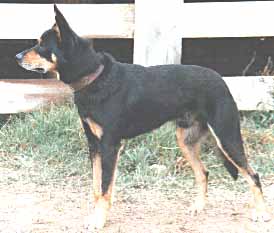
BLACK KELPIES
This was once a reasonably common colour in Working Kelpies but these days there are very few solid black Kelpies on pure working bloodlines. When they are available people that buy for colour will often pay a premium price. Some Australian Working Kelpie breeders have said they moved away from the colour to avoid any confusion that they were on Show Kelpie bloodlines.
The all black colour is still fairly popular with the Show Kelpie lines and is still shown at the Bench Shows but even there they are being pushed out in favour of the dark Chocolate coloured dogs with no white or tan markings.
The most famous black coloured Kelpie was the dog called 'The Barb' of the 1800's. This dog was a cross between two of the early Kelpie lines, the Rutherford Sheepdogs and the dogs of Elliot and Allen and from accounts of the period was a bit different in behaviour to Gleeson's Kelpie and Kings Kelpie and dogs on that line.
Barb became so well known that he started a whole line of dogs called 'Barbs'. They were used much more for close in work such as yarding sheep while the other line of Kelpies were mostly used out in the paddocks. Within the next ten or twenty years the two lines had been completely intermingled and there was no difference in working ability just from the colours. Even so, the Barb name has persisted and even today many people still call their black Kelpies, Barbs.
RED AND TAN KELPIES
The red & tan colouring is quite popular and would be the second most common colour.
The usual colouring is a medium reddish brown to dark chocolate with tan pips above each eye, around the sides of the face and up the legs. The tan often ranges from a dark golden colour to a very pale creamy lemon colouring. Non-Kelpie people and new owners would be more likely to call the colour a brown and beige.
Not everything is the same though. Some red & tan Kelpies have more tan on their face or legs or large pips above the eyes. Some are masked and some are even saddle marked, many have some banded hair and white markings (See appropriate sections).
There have been a lot of famous red & tan Kelpies. Among them are Waringa Mulga (won or placed in 35 trials), Liscannor Pace (Won/placed in more then 60 trials), Artesian Cloudy (Winner of two trials in one day), Noonbarra Butch (1992 Australian Yard Champion), Rockybar Gypsy, (winner of 16 trials & numerous placings), Karrawarra Sergeant, Capree Jag (Winner 1985 National Kelpie Trial), Barambogie Chance and many others.
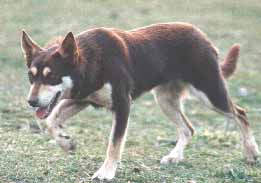
BRINDLE MARKINGS
There are not many Kelpies, if any, that would have brindle markings these days. We've never seen any. We have been told that in the past the famous Cudgee Working Kelpie Stud had a number of Kelpies with brindle down their legs. As the Cudgee Stud started out in the 1800's and bred a fairly related strain for many years it is assumed the colouring came from dogs of that era rather then crossbreeding at a later stage.
Gerald Kempe a well known sheepdog man from South Australia in the 1800's said that his dog, Saxon had brindle markings. He acquired this dog in 1886. Saxon was bred at the Kings family property at Hanging Rock near Wagga and was sired by their well known dog, Clyde. Saxon was quoted as ' a hard-haired, perfectly smooth dog with grizzly jaws and dark brindled tan points. Saxon later went on to win the Riverina Sheepdog Trials in 1884 and 1885.
Some of the earliest King & McLeod Kelpies were also reported to have brindle markings.
More information on Kelpie history can be found
in the latest edition of our book
We also have our new 2007 edition of The Rockybar Kelpies available
THE ROCKYBAR KELPIES
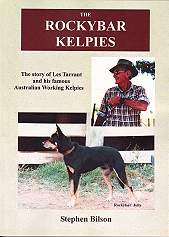
New for 2007, Kelpie history, Kelpie training, Kelpie breeding and great stories all from one of Australia's past best known Australian Working Kelpie Studs.
CLICK HERE FOR MORE INFORMATION
New 3rd edition of this very popular manual designed for all Kelpie owners of every level from raw beginners through to experienced trainers. This practical manual deals with everything involved in owning and training a Kelpie to ensure he grows up to be a well mannered, obedient dog.
The book is not about training on livestock! It deals with general obedience training, socialising your Kelpie, feeding, crating, toilet training, preventing problem behaviour, dominance issues, car travel, bathing, digging holes, stealing food, walking on a lead, coming when called... and much more.
Over 100 pages.
